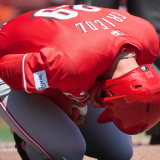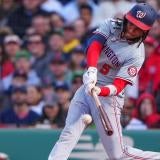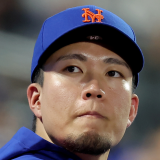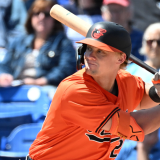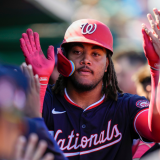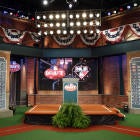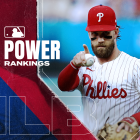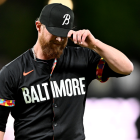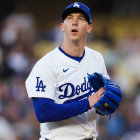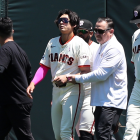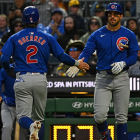Baseball's annual amateur draft is rapidly approaching. The three-day event begins Monday, June 4, and will cover 40 full rounds plus four shorter supplemental rounds for free agent compensation and competitive balance picks. As always, MLB Network will broadcast the first night of the draft live. This year the first 78 picks will be broadcast.
Inevitably, several future All-Star players will be drafted this summer. Possibly a future MVP or Cy Young winner too. Maybe even a future Hall of Famer. The vast majority of big league players are originally acquired through the amateur draft, though, unlike other sports, reaching the highest level takes time. Most drafted players spend years in the minors before reaching MLB.
With the draft inching closer, it's time to put together our first 2018 First Round Mock Draft, with an update to follow closer to draft day. Thanks to the latest collective bargaining agreement, all 30 teams have a first round pick this season. First round picks are now except from draft pick compensation. Every team has their first round pick this summer for the first time in a very long time.
In the interest of full disclosure, I will note I got exactly three picks correct in last year's mock draft. I got four picks correct the year before. Baseball's draft is very difficult to predict, so this is all little more than educated guesswork. Feel free to bookmark this post for future mocking purposes. Time for the mock draft. Come with me, won't you?
 1. Detroit Tigers: RHP Casey Mize, Auburn
1. Detroit Tigers: RHP Casey Mize, Auburn
The Tigers hold the No. 1 pick for the second time in franchise history -- they took Rice closer Matt Anderson first overall in 1997 -- and, as expected, they've cast a wide net for that pick. They've scouted everyone. This draft class lacks a clear cut No. 1 prospect, a Bryce Harper or Stephen Strasburg type, but Mize has separated himself from the pack these last few weeks. He is the overwhelming favorite to be the No. 1 pick this year.
In fact, Tigers GM Al Avila was in the house to personally scout Mize's start this past weekend. That's significant. The GM doesn't go to see every player. Only the players the team has serious interest in selecting.
Casey Mize is on the mound to begin what should be his final regular-season start as an Auburn Tiger.
— Josh Vitale (@AUBlog) May 18, 2018
Al Avila, the GM of the Detroit Tigers and owner of the No. 1 overall pick in next month's MLB Draft, is among those here to watch him.
Going into the weekend Mize, 21, owned a 2.73 ERA and an absurd 124/8 K/BB through 13 starts and 89 innings. His mid-90s fastball and low-90s splitter are both swing-and-miss pitches, and his slider has improved tremendously this spring.
With a solid build and good athleticism, Mize looks the part of a future workhorse who pitches near the front of a big league rotation. Barring injury, it's difficult to see the Tigers passing on Mize with the No. 1 pick. He offers high upside and a high floor, and chances are he'll zoom through the minors.
 2. San Francisco Giants: C Joey Bart, Georgia Tech
2. San Francisco Giants: C Joey Bart, Georgia Tech
Let's start with the elephant in the room: The Giants already have a franchise catcher in Buster Posey. MLB teams do not draft for need though, especially this high in the draft. You're doing yourself a disservice if you don't take the best player with the No. 2 pick, and besides, it's difficult to project MLB roster needs two or three years into the future.
Bart is a complete package behind the plate. He has a chance to be a middle of the order hitter with power and on-base ability, and he's a good defender with a strong arm and good reputation when it comes to working with pitchers. You can never rule out the Giants going for pitching, either high school or college, but right now a college bat is the scuttlebutt, and Bart is one of the best. He went into the weekend hitting .364/.473/.621 with 13 homers.
 3. Philadelphia Phillies: 3B Alec Bohm, Wichita State
3. Philadelphia Phillies: 3B Alec Bohm, Wichita State
Obvious statement is obvious: First round picks are important for every team every year. It is especially important for the Phillies this year, however. There are three reasons for that:
- Their last few first round picks aren't working out as hoped. That includes Mickey Moniak, the No. 1 overall pick in 2017. He's a career .245/.290/.341 hitter through 207 minor league games.
- With the big league team on the rise, the Phillies do not figure to pick this high again anytime soon. This year's draft may be their last chance to land a premium amateur talent for a while.
- The Phillies forfeited their second and third round picks to sign Carlos Santana and Jake Arrieta. After the No. 3 selection, their next pick isn't until the fourth round, the No. 107 overall selection.
The Phillies have been connected to college bats throughout the spring and Bohm is arguably the best pure hitter in the draft class. He's hitting .333/.435/.611 with 14 homers and more walks (36) than strikeouts (22) this spring, and projects to hit for average and power with high on-base percentages down the road. What position will Bohm play long-term? That remains to be seen. The bat is what will get him drafted within the first few picks. If Bart is still available here, the Phillies will jump on him.
 4. Chicago White Sox: 2B Nick Madrigal, Oregon State
4. Chicago White Sox: 2B Nick Madrigal, Oregon State
The White Sox typically skew toward college players early in the draft -- they haven't taken a high schooler in the first round since Courtney Hawkins in 2012 -- and they are not afraid of unconventional players. Madrigal is a devastating hitter -- he is hitting .458/.514/.635 through 23 games this spring -- and a very good defensive second baseman, and if he were a bit bigger than his listed 5-foot-7 and 160 lbs., he might go first overall. Madrigal missed a few weeks with a broken wrist earlier this year, but if the medicals check out, the ChiSox probably won't let him get beyond this pick, especially if Bart and Bohm are off the board.
 5. Cincinnati Reds: RHP Brady Singer, Florida
5. Cincinnati Reds: RHP Brady Singer, Florida
At the moment, the Reds are the biggest wild card early in the first round. They've been connected to all sorts of players, and with Mize, Bart, Bohm, and Madrigal off our hypothetical board, Singer fits best here. Singer was considered the favorite to go No. 1 overall coming into the draft season but has had an uneven spring -- his numbers are still very good: 2.25 ERA and 92/18 K/BB in 88 innings -- which has dropped him down some boards. Unless Mize or one of the top college bats is still sitting there for this pick, the Reds could go for Singer, who might have the highest ceiling in the draft.
 6. New York Mets: 3B Jonathan India, Florida
6. New York Mets: 3B Jonathan India, Florida
The Mets typically go after college performers and hitters early in the draft, and India combines the best of both worlds. He went into the weekend hitting .376/.520/.759 with 16 homers and more walks (45) than strikeouts (41) through 52 games, and he projects to be an impact all-around hitter with sneaky good defense. It is entirely possible a team will draft India and shift him to shortstop. Either Bart or Bohm would be the pick over India if they fall this far.
 7. San Diego Padres: RHP Carter Stewart, Eau Gallie HS (Florida)
7. San Diego Padres: RHP Carter Stewart, Eau Gallie HS (Florida)
Under GM A.J. Preller, the Padres have been all about upside, and there's no reason to think that will change. Stewart is the best prep player in the draft class, and with all the teams ahead of San Diego expected to target college players, he will fall right into Preller's lap. Stewart has a massive frame (6-foot-6 and 200 lbs.) and he's already throwing 95-97 mph with a swing-and-miss curveball. If Stewart comes off the board before this pick, expect San Diego to grab another high ceiling high schooler rather than a college player.
 8. Atlanta Braves: LHP Matthew Liberatore, Mountain Ridge HS (Arizona)
8. Atlanta Braves: LHP Matthew Liberatore, Mountain Ridge HS (Arizona)
Even with all their recent front office turnover, the Braves remain a pitching first organization, and new GM Alex Anthopoulos went heavy on pitching with his first round picks in Toronto. Stewart is the top target here. Liberatore is a fine consolation prize. He's a four-pitch guy (fastball, curveball, slider, changeup) with good command and pitchability. The Braves are more likely to go high school pitcher than college pitcher here.
 9. Oakland Athletics: 3B Nolan Gorman, O'Connor HS (Arizona)
9. Oakland Athletics: 3B Nolan Gorman, O'Connor HS (Arizona)
In recent years the Athletics have shifted away from high floor college players and instead focused on upside, which led them to A.J. Puk in 2016 and Austin Beck in 2017. Even in trades, the A's have been going after upside (think Dustin Fowler and Jorge Mateo in the Sonny Gray deal) over probability because they simply can't afford star caliber players in free agency. They have to grow their own. Gorman has arguably the most raw power in the draft class -- he's put on serious batting practice displays at big league ballparks during summer showcase events -- and he's a smart hitter as well. He's not a brute grip it and rip it masher. The A's take India if he's still on the board here. A bat is more likely than an arm.
 10. Pittsburgh Pirates: RHP Grayson Rodriguez, Central Heights HS (Texas)
10. Pittsburgh Pirates: RHP Grayson Rodriguez, Central Heights HS (Texas)
The Pirates have been most connected to high school pitchers here and Stewart or Liberatore would be the dream scenario. Absent that, Rodriguez fits best, and it's possible Pittsburgh will cut a pre-draft deal to sign Rodriguez below slot, allowing them to spend more aggressively with their extra competitive balance draft pick (No. 36). The Pirates have been very heavy on bats in recent years -- five of their six first round picks since 2013 were hitters -- and the tide seems to be shifting back to arms.
 11. Baltimore Orioles: LHP Shane McClanahan, South Florida
11. Baltimore Orioles: LHP Shane McClanahan, South Florida
Player development has been an issue over the years, especially with pitchers, though the Orioles have always targeted high upside players. You can't blame their draft strategy for their current MLB woes. It's the player development more than anything. Anyway, McClanahan has touched 100 mph in the past and his changeup is a knockout pitch, maybe the best offspeed pitch in the draft class. A still developing breaking ball and a fairly stiff delivery are giving some teams pause, but left-handers with this much velocity usually don't last long on draft day. The O's have been mostly on college arms this spring.
 12. Toronto Blue Jays: RHP Logan Gilbert, Stetson
12. Toronto Blue Jays: RHP Logan Gilbert, Stetson
Stetson has produced some high-end big league hurlers in recent years (Jacob deGrom and Corey Kluber, most notably) but they've never had a pitcher taken in the first round. Gilbert will be the first. He was a potential top five pick before pitching much of the spring with slightly reduced velocity, though the four-pitch package and fierce competitiveness will still get him drafted high. The Blue Jays have been tied to college arms these last few weeks and Gilbert is the best still on the board here.
 13. Miami Marlins: OF Travis Swaggerty, South Alabama
13. Miami Marlins: OF Travis Swaggerty, South Alabama
The Marlins have new ownership and a new front office -- and a new scouting director, at that -- so it's anyone's guess how they will approach this draft. Getting Swaggerty here would be a coup. He's a high-end college performer -- Swaggerty owns a career .321/.458/.513 batting line with 27 homers and more walks (135) than strikeouts (126) through 163 games -- who is expected to move through the minors quickly. That'd be a great fit for the Marlins. Swaggerty is reportedly in the mix for several teams in the top 10, however, and may not last this long.
 14. Seattle Mariners: OF Trevor Larnach, Oregon State
14. Seattle Mariners: OF Trevor Larnach, Oregon State
When in doubt, mocking a college bat to the Mariners is never a bad idea. Their last five first round picks were hitters and four of the five came from the college ranks. They'd love Bohm, India, or Swaggerty here, though they all seem unlikely to be available. Larnach is the best college hitter still on the board, though the Mariners would have to pass over several highly regarded prep players to take him.
 15. Texas Rangers: OF Jarred Kelenic, Waukesha HS (Wisconsin)
15. Texas Rangers: OF Jarred Kelenic, Waukesha HS (Wisconsin)
Including the supplemental first round, the Rangers have had 10 first round picks since 2012 and all but two of them were high school players. No sense in bucking that trend here. Kelenic will be the seventh player ever drafted out of Wisconsin in the first round this year -- he'll be only the second Wisconsonite taken in the first round since 1988 -- and, had he grown up in a traditional baseball hotbed like California or Florida, he might go in the top 10 picks. He has strong offensive potential and good athleticism. The Rangers are in on all the top high school players. All of 'em.
 16. Tampa Bay Rays: OF Jordyn Adams, Green Hope HS (North Carolina)
16. Tampa Bay Rays: OF Jordyn Adams, Green Hope HS (North Carolina)
The Rays have three extra picks this year -- they have three of the top 32 selections in the 2018 draft -- and thus the second largest bonus pool, which allows them to shoot for the moon. Adams is a premium athlete with tremendous tools, and because he's a top wide receiver recruit, it is going to take a substantial bonus to lure him away from UNC. If the Rays don't want risk the draft pool space -- failing to sign any player means losing the bonus money associated with that pick -- they figure to target other top high school bats, including Kelenic or Tampa's own Connor Scott.
 17. Los Angeles Angels: LHP Ryan Rolison, Ole Miss
17. Los Angeles Angels: LHP Ryan Rolison, Ole Miss
It is rumored to be college pitching all the way for the Angels, and Rolison is the best still on the board here. The southpaw has arguably the best curveball in the draft class, and his deep repertoire includes a low-to-mid-90s heater, a little cutter/slider, and a changeup. Rolison, McClanahan, and Gilbert are all expected to come off the board somewhere in the 11-17 range. The Halos will jump whichever one of them is still available.
 18. Kansas City Royals: OF Connor Scott, Plant HS (Florida)
18. Kansas City Royals: OF Connor Scott, Plant HS (Florida)
The Royals have three extra picks this year thanks to their free agent defections, and thus the largest bonus pool. And, given the fact they are in the early stages of their rebuild, this is a very important draft for them. Kansas City has been mostly tied to high school bats this spring, a demographic they've had a lot of success with over the years, and Scott is the kind of pure hitter and high-end athlete the Royals love. Adams and Kelenic are also in the mix here.
Don't be surprised if the Royals cut a deal with a lower ranked player with this pick, then use the bonus pool savings to go after elite players who fall out of the first round with their two supplemental round picks (Nos. 33 and 34). It is a common strategy for teams with extra picks these days and the Royals themselves did it in 2013, when they took Hunter Dozier in the first round and splurged for Sean Manaea in the sandwich round.
 19. St. Louis Cardinals: RHP Jackson Kowar, Florida
19. St. Louis Cardinals: RHP Jackson Kowar, Florida
The Cardinals did not pick until the third round last year after giving up their first rounder to sign Dexter Fowler and forfeiting two other picks as discipline for the hacking scandal, and it seems likely they'll go back to the college ranks after going heavy on high schoolers in recent years. Some prefer Kowar to Singer and former Florida hurler Alex Faedo, a first round pick last year, even though they received more attention leading up to the draft. Kowar fits the Cardinals' mold as an athletic pitcher with a great changeup and good pitchability. St. Louis would love to get McClanahan or Rolison here.
 20. Minnesota Twins: Ryan Weathers, Loretto HS (Tennessee)
20. Minnesota Twins: Ryan Weathers, Loretto HS (Tennessee)
Since 2012, the Twins have used seven of their nine first round and supplemental first round picks on high school players, and in our hypothetical draft Minnesota will have their pick of second tier prep arms here. Weathers is the son of longtime big leaguer David Weathers, and he pitches like you'd expect the son of a big leaguer to pitch. He's very polished and he knows how to set hitters up. Weathers has pretty good stuff too, including low-90s gas and a big breaking curveball. Given the draft class, a pitcher seems more likely than a hitter here.
 21. Milwaukee Brewers: RHP Kumar Rocker, North Oconee HS (Georgia)
21. Milwaukee Brewers: RHP Kumar Rocker, North Oconee HS (Georgia)
Under GM David Stearns, the Brewers have employed a very straightforward "best player available" approach. Hitter, pitcher, college, high school, whatever. Rocker is the son of former NFL player Tracy Rocker, and he has the most upside of any pitcher still on the board here. In fact, he was in the mix for the top 10-15 picks before a few sluggish outings late this spring. Given his present stuff (mid-90s heater and wipeout slider) and athleticism, Rocker is the kind of pitching prospect who could come out of college as a No. 1 pick candidate in three years, especially since he's committed to Vanderbilt, a top pitcher development program.
 22. Colorado Rockies: C Anthony Seigler, Cartersville HS (Georgia)
22. Colorado Rockies: C Anthony Seigler, Cartersville HS (Georgia)
The Rockies love love love their power arms, but they've been heavily scouting Seigler in recent weeks, and he is one of the draft's top risers as a switch-hitting -- and switch-throwing! -- catcher with offensive upside and strong defensive chops. Given the recent buzz, it would be a surprise is Seigler doesn't go in the first round at this point. High school pitching would be the alternative for Colorado here, with Rocker, Weathers, and Rodriguez among the top targets.
 23. New York Yankees: RHP Cole Winn, Orange Lutheran HS (California)
23. New York Yankees: RHP Cole Winn, Orange Lutheran HS (California)
Scouting director Damon Oppenheimer has a known affinity for Southern California prospects, and although they have been connected to bats more than anything this spring, I don't think they'll pass on Winn if he's still available. Winn is the best SoCal prospect in the draft class and he's a polished prep pitcher with a good delivery and good pitching know-how. Furthermore, the Yankees are analytical organization and Winn has posted very high spin rates in showcase events. The Yankees have cast a wide net for prep bats should Winn be off the board here.
 24. Chicago Cubs: RHP Ethan Hankins, Forsyth Central HS (Georgia)
24. Chicago Cubs: RHP Ethan Hankins, Forsyth Central HS (Georgia)
The Cubs are in an interesting position this year. They have two extra picks thanks to the Arrieta and Wade Davis free agent defections, though they're late picks (Nos. 77 and 78), so they can't really cut a deal here and use bonus pool savings on top talents who fall. More likely, the Cubs will use the extra bonus pool space to go big with this pick, and Hankins was in the mix for the No. 1 selection this year before a relatively minor shoulder injury cost him a month earlier this spring. The big league team's success means Chicago no longer has access to premium talent at the top of the draft. Hankins is that type of player though, and if the Cubs are comfortable with the medicals, they could use the extra bonus money from those two extra picks to pay overslot here. Seigler or any of the college arms could be options here as well.
 25. Arizona Diamondbacks: SS Brice Turang, Santiago HS (California)
25. Arizona Diamondbacks: SS Brice Turang, Santiago HS (California)
Tough to pin the Diamondbacks down this year. I'm guessing their front office will be opportunistic and grab Turang, who was considered the top high school position player in the draft class coming into the spring. A so-so senior season and a case of overexposure -- Turang has been on the draft radar for years now, and at this point scouts have nothing left to do but nitpick his game -- has him sliding down draft boards. The D-Backs could bet on the tools and track record, and grab the type of talented up-the-middle player rarely available this late in the first round.
 26. Boston Red Sox: RHP Mason Denaburg, Merritt Island (Florida)
26. Boston Red Sox: RHP Mason Denaburg, Merritt Island (Florida)
When picking late in the first round, the Red Sox tend to be opportunistic and grab whichever highly regarded player falls into their laps. Hankins and Turang are possibilities here, though since they're off the board in our mock draft, Denaburg is the guy. He was climbing draft boards earlier this spring before coming down with a biceps issue. When healthy, he showed a mid-90s fastball and wipeout breaking ball, and there's some belief Denaburg has more to give once he focuses on pitching full-time. He currently splits his time between pitcher, catcher, and the outfield, and he plays football as well.
 27. Washington Nationals: RHP Mike Vasil, Boston College HS (Massachusetts)
27. Washington Nationals: RHP Mike Vasil, Boston College HS (Massachusetts)
Because they're always picking late in the first round, the Nationals usually just jump on the top talent still on the board, even if there are injury concerns (Lucas Giolito, Erick Fedde) or makeup issues (Seth Romero). Vasil left a start holding his elbow a few weeks ago, but structural damage was ruled out -- "muscle fatigue" is the vague publicly available diagnosis -- and he was given the green light to return to the mound last week. Prior to the injury Vasil was a no-doubt first round talent with a low-to-mid-90s fastball and two promising secondary pitches in his curveball and changeup. Hankins, Turang, and Denaburg are all possibilities here as well.
 28. Houston Astros: OF Nick Schnell, Roncalli HS (Indiana)
28. Houston Astros: OF Nick Schnell, Roncalli HS (Indiana)
Not surprisingly, the Astros have been tied to several analytics friendly prospects, including Winn (spin rate), Rocker (spin rate), and Florida high school first baseman Triston Casas (exit velocity). Schnell is a fast riser who is shooting up draft boards this spring thanks to his power bat, his speed, and his well-rounded game. Prep bats in cold weather states are getting more scouting attention than ever these days after Mike Trout slipped through the cracks, and guys like Schnell are benefiting.
 29. Cleveland Indians: OF Alek Thomas, Mount Carmel HS (Illinois)
29. Cleveland Indians: OF Alek Thomas, Mount Carmel HS (Illinois)
Like Schnell, Thomas is another fast-rising prep bat from a cold weather state. The Indians have been very heavy on high schoolers in recent years -- six of their nine first and supplemental first round picks since 2011 have come from the prep ranks -- and Thomas' exciting tools and athleticism point to a future as a power/speed leadoff type in the Grady Sizemore mold. Turang, Casas, and Schnell are also options here. I don't think Seigler drops any further than this pick.
 30. Los Angeles Dodgers: RHP Sean Hjelle, Kentucky
30. Los Angeles Dodgers: RHP Sean Hjelle, Kentucky
The Dodgers have gone for college players with premium tools in two of their three drafts (Walker Buehler and Jeren Kendall) under president of baseball operations Andrew Friedman, and I'm guessing they'll do the same this year. Hjelle is a monster at 6-foot-11 and 215 lbs., and that frame makes it easy to believe his current low-90s fastball will grow into a consistent mid-to-upper-90s offering in time. Add in a hellacious curveball and a sneaky good delivery for a pitcher this size, and Hjelle seems like a classic upside play for the Dodgers. They've also been tied to prep bats like Scott and Thomas this spring.







